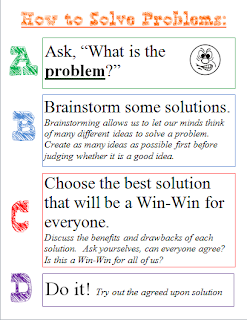A few months ago, bullying became a buzz word at my
school. Our AA and I heard it all of the
time. We brought in a bully show from a
local community theater group, and I had done various lessons on bullying in
classrooms, so the kids had been hearing the
word “bully” a lot. A lot of the notes I
received from students was thus about “bullying” situations. One thing that stood out to me was
that when I followed up with the letters students were writing me about being “bullied,” many actually turned out to be more about conflict resolution than
bullying. Some of the students just didn’t
know how to get along w/ each other when there was a problem and resorted to
understanding the problem from the language they had been hearing around the
school: I have a problem, so I must be getting bullied. Others it seemed really did have bullying situations going on, and my AA and I felt at a loss for how to stop it all. As a school, we all needed to understand and
be on the same page about the definition of bullying, what it looks like and
how we can choose to be a peaceful school.
So, I got together a plan to teach our students and teachers
the definition of bullying and invite a discussion on how to bring peace to our
school. However, there is only one of me
and I didn’t think it made sense for me to switch up my curriculum in the
middle of the year to do a bullying lesson in each class. Instead, I used an app on my ipad called
Educreataions and created a digital storytelling video to define bullying. (Educreations allows you to create videos
that are basically like a digital white board.
I used pictures and recorded myself talking and writing.) I emailed the video out to all teachers (with
admin’s blessing) and asked that they find a time to show it and reflect the
discussion following the video in their lesson plans. After they watched my video, I directed them
to a skit of the Juice Box Bully that I found on YouTube. If you have never read this book and you are
interested in promoting peace to end bullying then it is a MUST read J I really liked that at the end of the skit,
the kids all signed a Peace Promise saying that they would not stand by and
watch bullying happen.
So, of course my students needed to sign a peace promise
too! I put up a bulletin board with
facts about bullying surrounding the Peace Promise and asked my teachers to
have their students all sign it after lunch the day that they showed the
videos. The students loved it—and it has
been a great tool to help students recognize that bullying isn’t cool or funny,
but terribly hurtful and rude! I think
it is such a simple thing, but has brought a visual of peace and community to our school.







